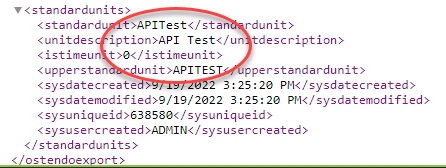Ostendo API and Freeway Connection Troubleshooting


There can be numerous reasons why the Ostendo API may not be running. This topic provides a simple checklist of the most common API and Freeway connection issues and solutions.
This topic assumes you are attempting to use the Ostendo API with Freeway, however most points here are also relevant to an API where Freeway is not being used.
When diagnosing a connection problem between Freeway and Ostendo, you need to break the problem down into parts, starting at the source (Ostendo API) rather than the termination point (Freeway) first.
The Diagnostic Process
Check the API is running
- From the Services screen check for the Ostendo Rest API Service and determine if that is currently 'Running'. If not, 'Restart the Service and then wait for a couple of seconds then refresh the screen to check if it is still 'Running'. If not, something to preventing it from connecting.
- Ensure you installed the API service using the setting "Run as Administrator". This process elevates the privileges when installing any software to ensure all appropriate windows files are installed / updated correctly. If you have inadvertently installed the API without Administrator privileges, we recommend uninstalling the API and Re-installing again this time taking the "Run as Administrator" option.
- Ensure the API Service Configuration has been configured to the correct
- HTTP or HTTPS Port
- If HTTPS is being used,
- Ensure the 'Use HTTPS' is ticked
- Ensure a Valid Security Certificate exists has been specified here
- From the Config 0 Tab
- Ensure the Active box is ticked
- Ensure 'Allow Freeway Access' is ticked
- Try Restarting the Service and then check the Windows Event Log for clues (from Windows Event Viewer). Checking for Source 'ostapisvc'
- Ensure both of these sites are available from the network you are attempting to connect from
- www.freewayapi.com
- http://api.ipify.org
- Antivirus software - Try temporarily turning off antivirus software to see if that makes a difference.
- Eliminate Firewall exceptions by temporarily turning of Window Firewall.
Ostendo License availability
- The API requires the use of one local Ostendo license. Check Ostendo Help -> About to determine how many licenses are assigned to this site. Then check Active Connections to determine they are not all being used.
Check the API is connected to the (correct) Ostendo Database
- From the API Configuration screen (File -> API Configuration ->Config 0 tab) ensure the correct Ostendo database and path has been defined.
Eliminate whether its a connection issue eg: WIFI Vs Remote
- When connecting Freeway remotely you require Port Forwarding turned on at the Router, however this is NOT required when connecting by WIFI. Therefore eliminate port forwarding by attempting to connect to the WIFI network.

|
It is important to note that when Freeway is set to connection 'Local', this means that the device must connect to the specific WIFI network that the Ostendo API is running from. eg: You cannot use Freeway in Local connection mode when connected to any WIFI network other than that of the Ostendo API server. |
- If you are able to connect Locally but not Remotely then the problem is either a weak internet connection at the Device or Port Forwarding is not turned on
- Connected as 'Local' has been designed principally for devices (usually tablets without SIM cards) to be used exclusively within the bounds of the WIFI network. Whereas it is recommended that Mobile Phones or any device with a SIM card be configured as 'Remote' permanently. It is suggested that users do NOT toggle between these settings for any one device.
Mobility or API License Validity
- Freeway requires two authentication codes in order to connect
- Mobility License (Mobility -> Settings -> Mobility Rules) This license must be valid and NOT used by any other Ostendo database (copy or otherwise). Also ensure that the appropriate License Code Update Option has been taken for you're environment.
- API License (File -> API Configuration -> API Security). Ensure this license record has been configured correctly.
- Ensure SQL Allowed is turned on
- API Key for has been set to the appropriate setting for this Freeway User eg: Internal / Mobility B2B or Mobility SubContractor.
Determine the issue is localised to one or all Freeway Users for this site?
- This may give a clue as to what may have happened. If it's just one or a new user then...
- Check that users Mobility Settings (Mobility - > Employee Mobility Settings). Check they have the correct Employee Style for the API Security key that has been generated
- Run Diagnostics from within Freeway to determine whether they can in fact connect to the API. Check the Port Number displayed and IP address to confirm they are actually connecting back to the source.
- Restart the API Service and then regenerate a new Fastcode and apply that to the device and test again
- If connection type is set to Local...
- Ensure there is a good signal
- the device must be on the same network as the Ostendo API is running on
- If the connection type is set to Remote
- Ensure WIFI is turned off
- Ensure there is a good Remote signal eg: 4G etc..
Freeway Not Communicating Locally when configured for Remote
There are some environments where you may find when the Freeway Setting "Network" is set to "Remote", it works fine outside of the organisations Wifi network, however when that device is connected to that organisations WIFI network, the API connection fails and displays an error.
This error is caused by that organisations router, not being able to convert the External IP address back into the Local IP Address. Most recent models of routers allow for this, however some do not. Therefore this is a router problem rather than a Freeway problem.
- You can prove this is the case by entering in the External IP Address and Port ("External IP Address":"Port Number") into a web browser that is connected to that organisations network. If the page fails to load, this indicates the problem described above.
- To resolve this problem, it is suggested you contact that organisations IT Support Provider and convey the following:
"The router is unable to convert the External IP address back into the Local IP Address"
If Freeway has been working correctly recently, but does not now, What has Changed?
- IT Company perhaps enforcing new security policies. Closing down ports / Web Addresses?
- New Hardware - Server / Android or IOS Device / Router?
- Updates to Software - Antivirus or Firewall or Operating Software on Server / Device?
- New or existing Staff member changing / deleting some Freeway configuration either in Ostendo or on the mobility Device
Prove you are actually connecting to the Ostendo Database you think you have configured
If the API is working however for some reason the data being sent from Ostendo to Freeway or back again is not what you expect, it could be that you have configured the API and are therefore connecting to the wrong Ostendo database. To prove you are connecting to the intended database perform the following checks.
- From within the Ostendo database setup a new Standard Unit called "APITest" (General -> Settings ->Standard Units) (You will delete this unit later)
- Enter in the External or Internal IP Address and Port ("External IP Address":"Port Number") into a web browser that is connected to that organisations network.
- The following screen should be returned confirming your API connection (NB: The version number may differ from that shown however it should always represent the latest Published API version

- Click on Resource List and scroll down until you see the tabledata with a Type of 'Get'

- Click on the link to display all returned Standard Unit from the Ostendo database
- You should see the "APITest" Standard Unit. If you don't then your API is actually connected to a different Ostendo database. Ensure your API Configuration path is correct (File -> API Configuration ->Config 0 tab)

- Once the test has been completed successfully you should delete the APITest Standard Unit record from Ostendo